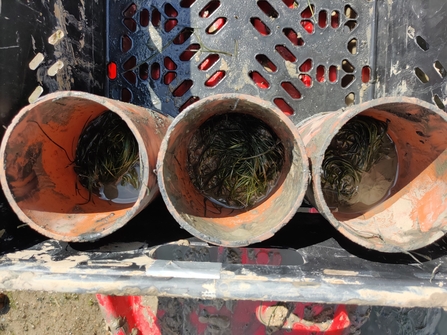Conservation Matters: August

As part of the Essex Seagrass Project, our Marine Team have been at St Lawrence, one of the designated sites for seagrass surveys. Here, the team have been trialling different methods for seagrass transplants, in order to restore this vulnerable by important species across the Essex coastline. The photos show the use of seagrass cores. These work by taking samples of healthy, abundant seagrass and planting them in areas where seagrass has the potential to grow. We look forward to updating on the success of this.
Welcoming back conservation grazers
The Conservation Team have been busy introducing grazing livestock across our nature reserves, so keep an eye out at our sites for our four-legged helpers.
Fingringhoe Wick Nature Discovery Park's Ranger, Alex, tells us why they are important additions to our reserves:
“Conservation grazing is a great way of mowing grasslands and meadows whilst also increasing biodiversity. Natural regeneration is encouraged by certain grazing traits. Balanced grazing reduces the prevalence of vigorous plants that outcompete more fragile species, creates microclimates and areas of bare ground through trampling and disturbance from lying down, and diversity through selective grazing methods. The bare earth and dung is also a valuable resource for invertebrates. This increase in diversity of plant species has a positive effect for animals such as butterflies, bees, bats and birds. Grazing using livestock also reduces the usage of heavy machinery and fuel consuming equipment.”
Mapping nature reserves
We are using remote sensing on some of our reserves to supplement the on-the-ground surveys and provide us with detailed habitat information.
At Willow Park, Langdon, we recently had a drone survey carried out to help assess habitat opportunities for insects. By collecting several types of imagery, including temperature maps, structure maps elevation maps and vegetation types, we can learn more about the microhabitats present. The more microhabitats, the better the potential for a range of invertebrates to thrive.
Baby avocets
This season it has been positive to see successful breeding on many of our sites. These baby avocets were photographed by Kathleen Greenwood as they changed from fluffy chicks to young adults, at Two Tree Island nature reserve. It is great to see that the management of this site is supporting endangered birds like this.
How can you help?
Our conservation projects would not be possible without your support. Become a member of Essex Wildlife Trust today, and help us make conservation happen.



